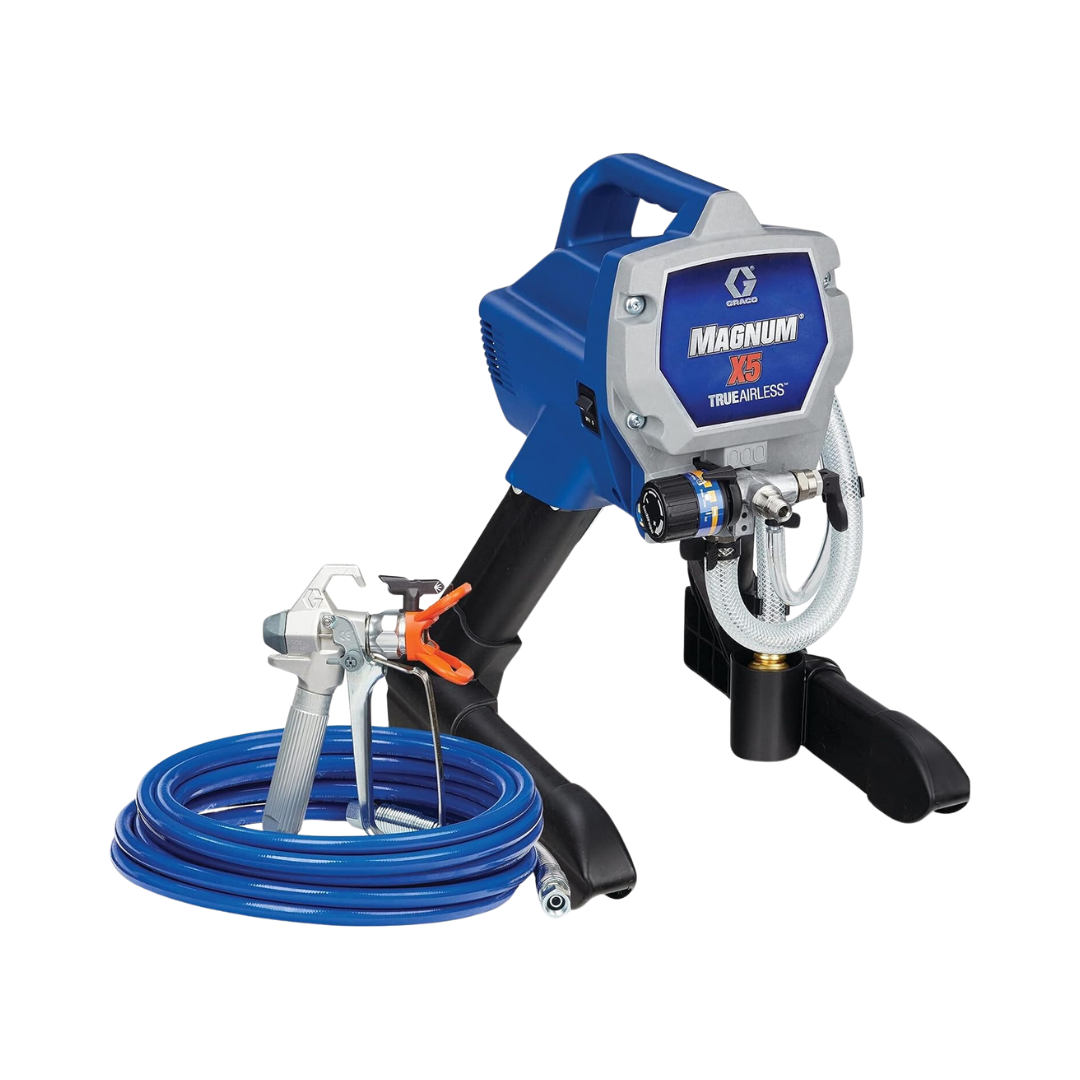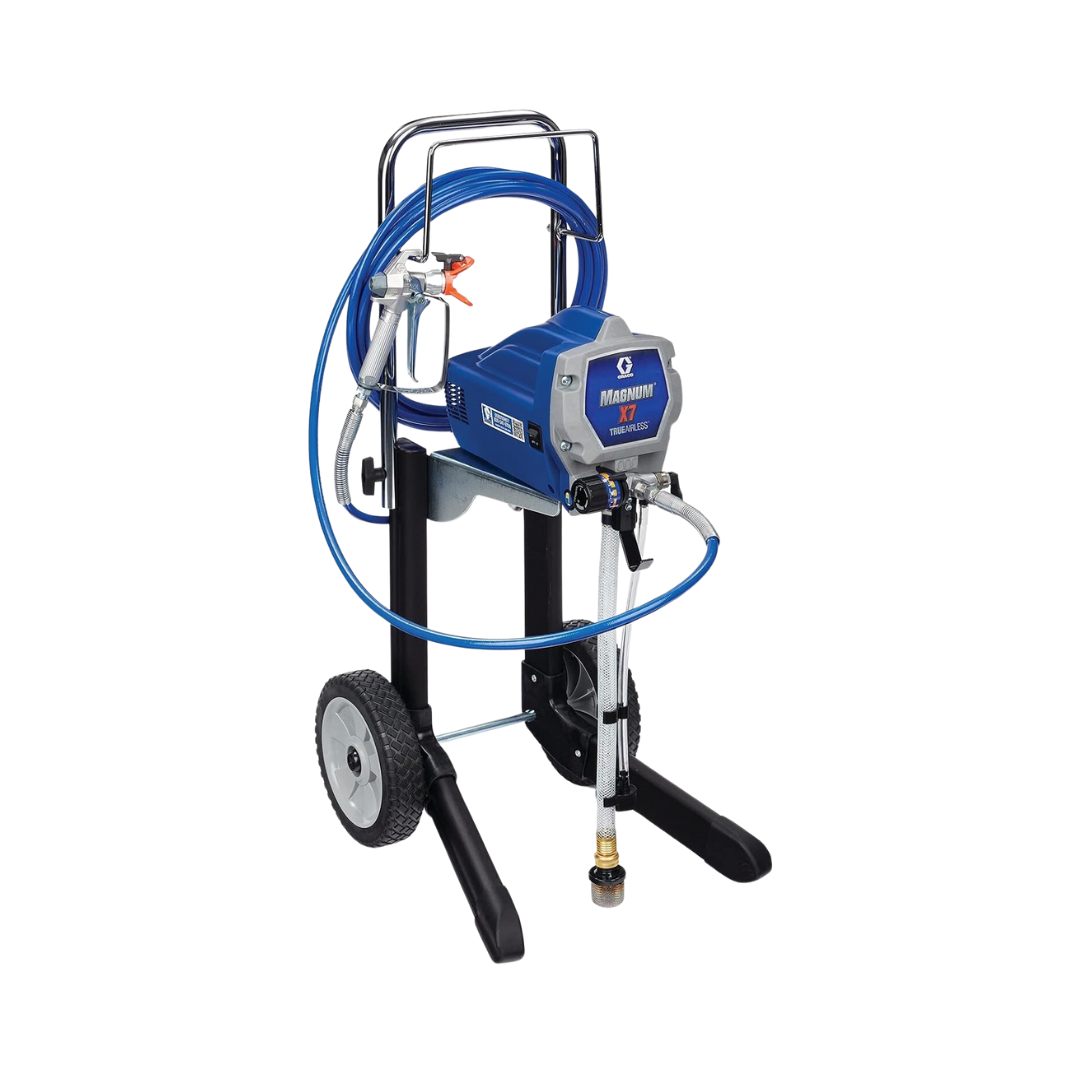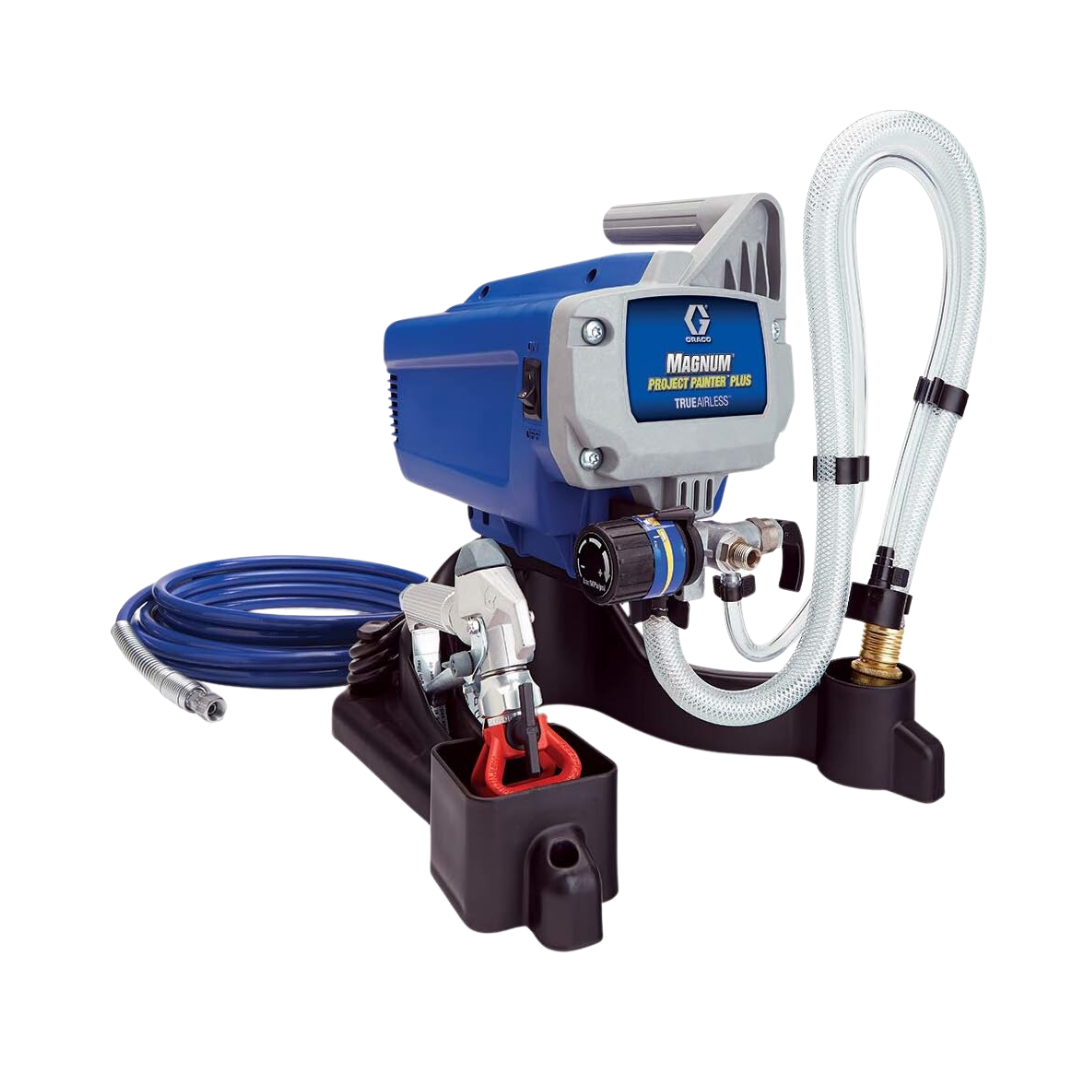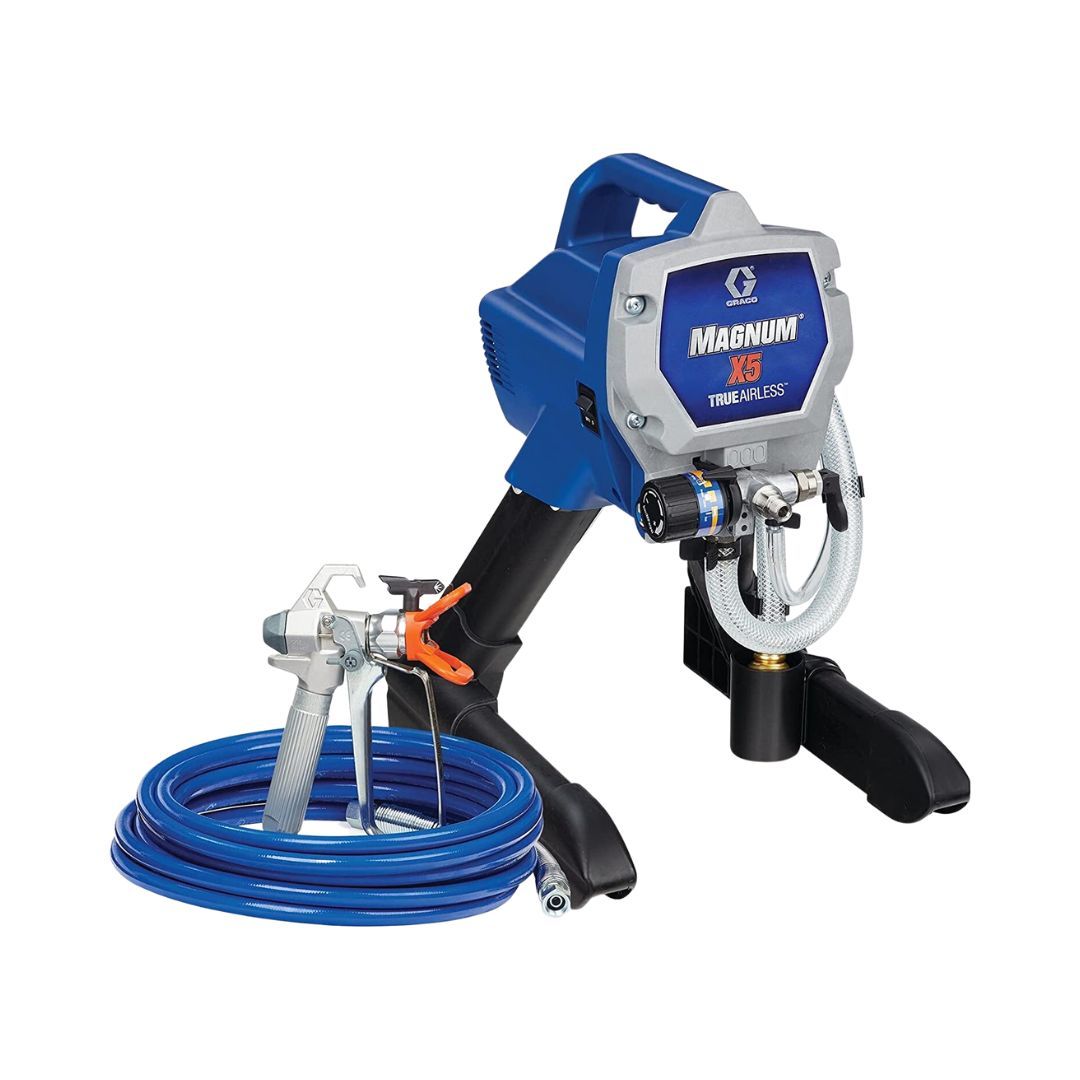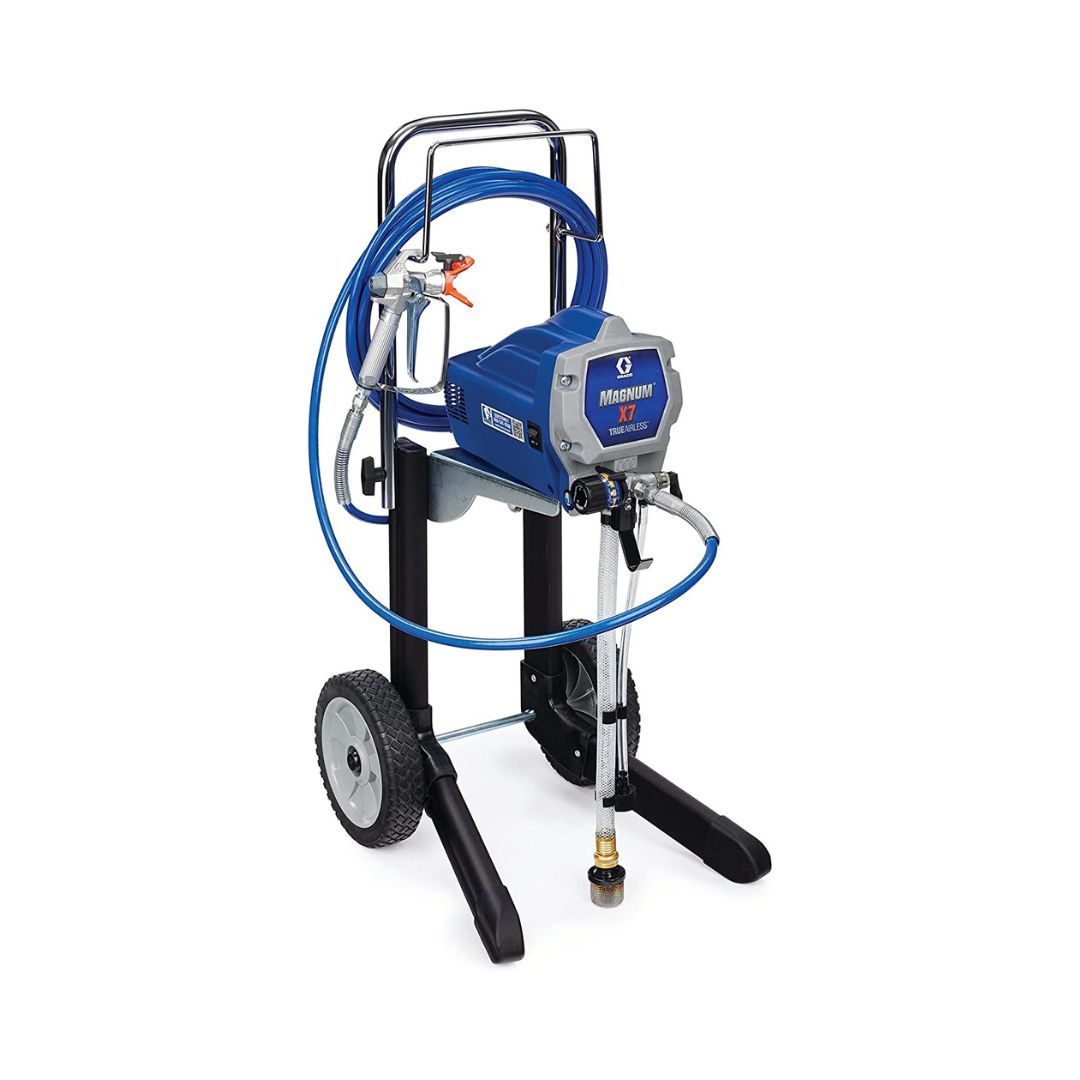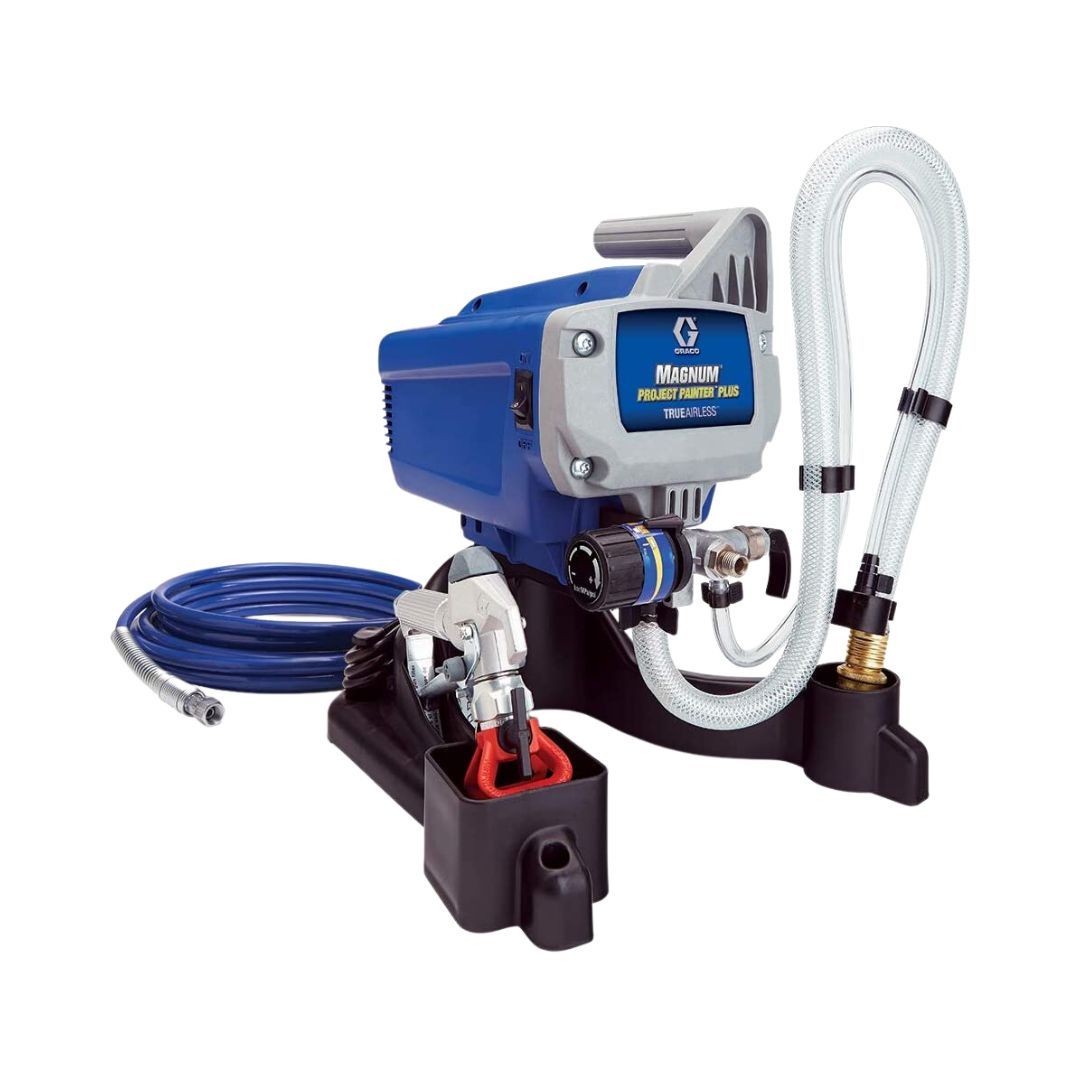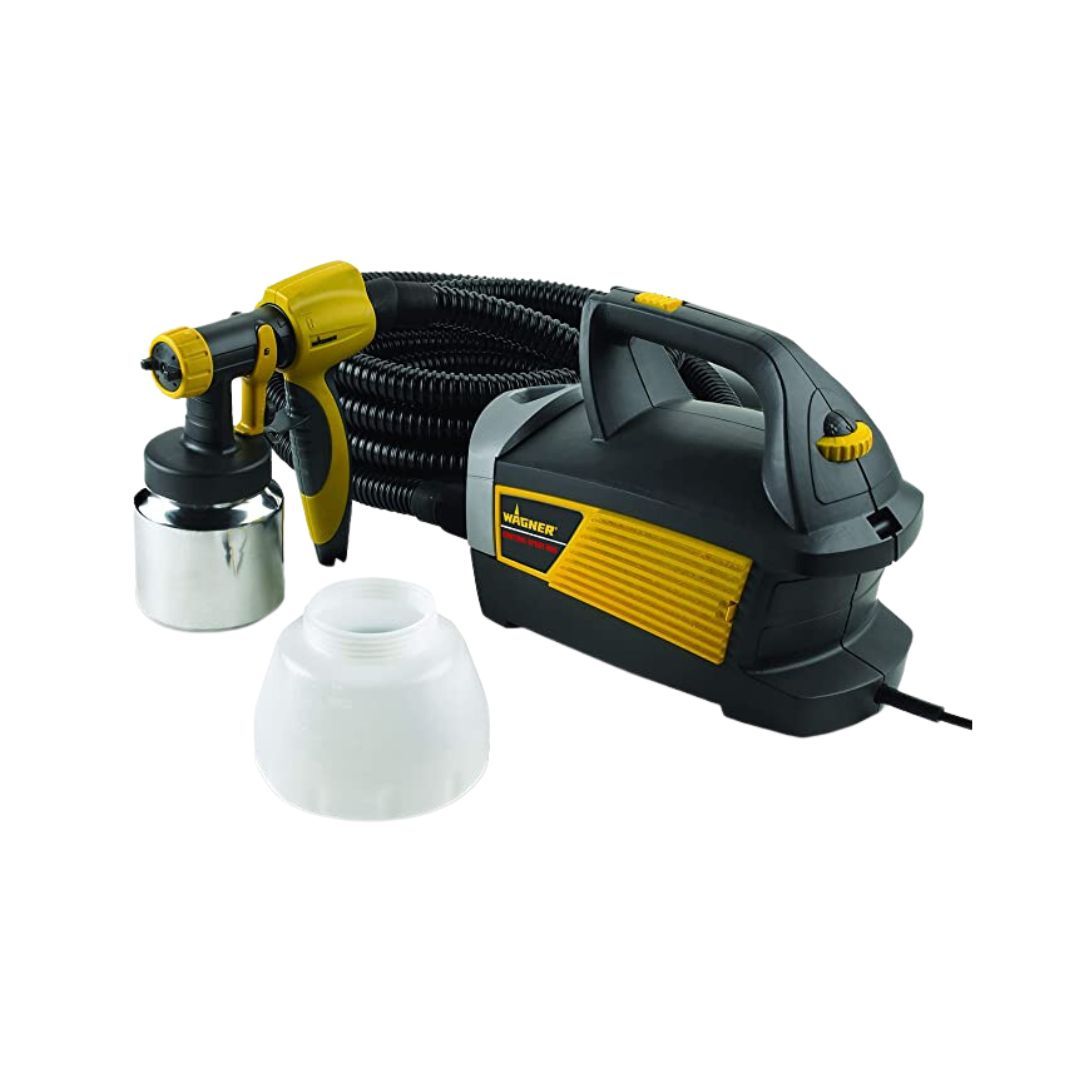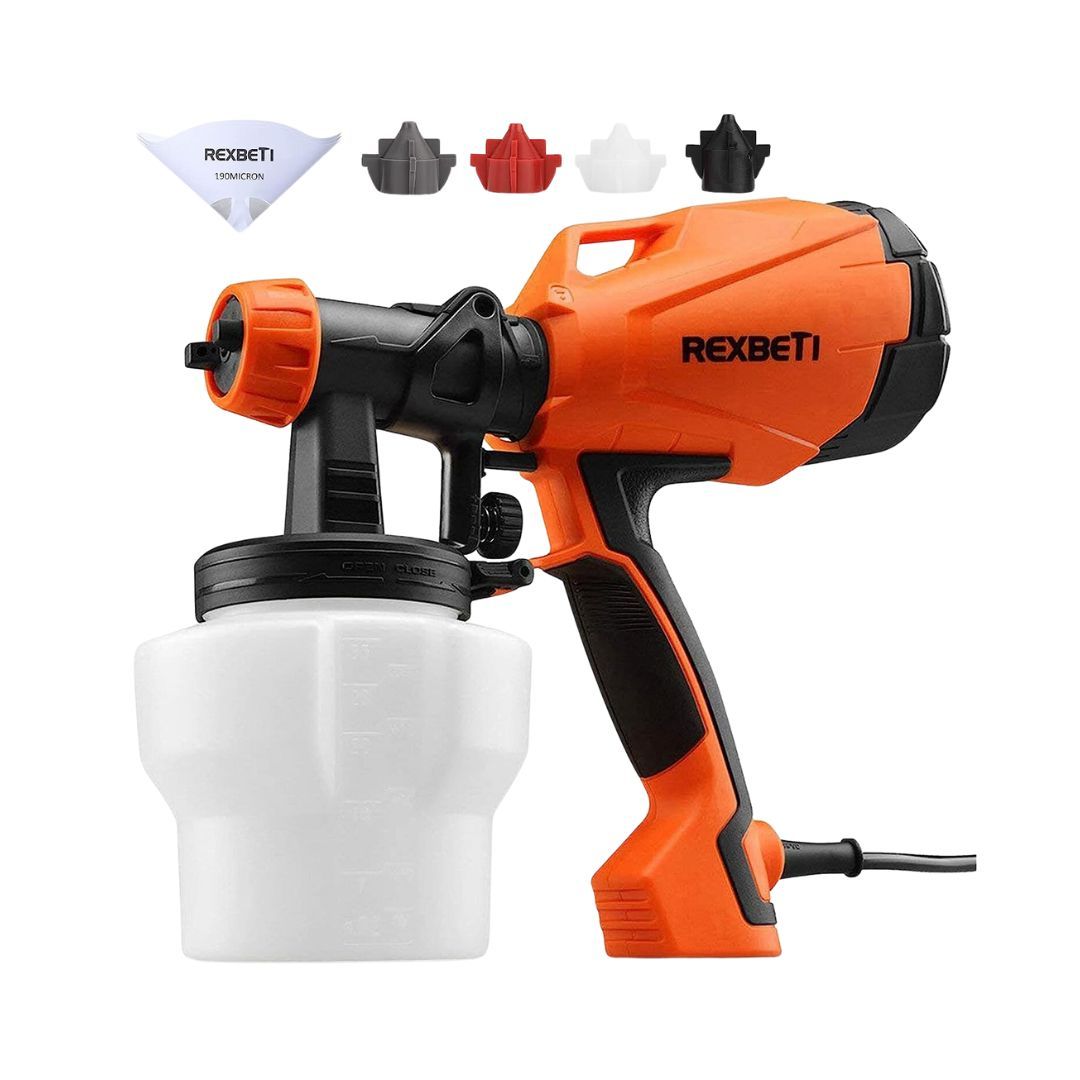We may be compensated if you purchase through links on our website. Our team is committed to delivering honest, objective, and independent reviews on home products and services.
- We rate the Graco 262800 Magnum X5 Stand Airless Paint Sprayer as the best paint sprayer on the market due to its quick application and ease of use.
- The paint sprayers in our review cost between $40 and $430, leaving a wide price range to meet your budget and needs. The price will depend on flow rate and build design which can impact the quality of your paint job.
Paint sprayers have an obvious advantage: They can spread paint, stains, and clear finishes faster than any brush or paint roller. But just as important is their ability to apply an even coating to uneven surfaces like window shutters and stair balusters. They can create a mirrorlike finish on cabinets or furniture where even minor brush marks can be noticeable.
While there are several high-quality paint sprayers available, we like the Graco 262800 Magnum X5 Stand Airless Paint Sprayer the best. It boasts an excellent flow rate and it’s easy to clean after use, allowing you to get countless mistake-free paint projects done.
To help you find the best paint sprayer for your paint job, we examined the top models on the market. We’ve also provided some essential information on factors that may influence the type of paint sprayer you use, along with some how-to tips on using a paint sprayer. Here are our top picks.
Top 5 Paint Sprayers
*Links open to product retail page.
- Best Overall: Graco 262800 Magnum X5 Stand Airless
- Best Cart: Graco 262805 Magnum X7 Cart Airless
- Best Storage: Magnum Project Painter Plus
- Best for Stains: Wagner Spraytech Control Spray Max HVLP
- Most Portable: REXBETI Ultimate-750
Compare Top Paint Sprayers
| Product | Flow Rate | Spray Method | Included Materials | Weight |
|---|---|---|---|---|
| Graco 262800 Magnum X5 Stand Airless Paint Sprayer | 0.27 GPM | Rests on a stand | Comes with a 25-foot paint hose | 19 pounds |
| Graco 262805 Magnum X7 Cart Airless Paint Sprayer | 0.31 GPM | Rests on a cart with wheels | Comes with a 25-foot paint hose | 26 pounds |
| Graco 257025 Magnum Project Painter Plus Paint Sprayer | 0.24 GPM | Rests on a stand | Comes with a 25-foot paint hose | 16 pounds |
| Wagner 0518080 Spraytech Control Spray Max HVLP Paint or Stain Sprayer | Not listed | Has a handle for holding | Comes with one- and 1.5-quart cups and a 20-foot paint hose | 11 pounds |
| REXBETI Ultimate-750 Paint Sprayer | 0.2 GPM | Has a rubber handle for holding | Comes with a 100-milliliter cup, a cleaning needle, four nozzles, and give paint strainers | 4 pounds |
| Product | Flow Rate | Spray Method | Included Materials | Weight |
Best Overall
Key Features
- Has a flow rate of 0.27 gallons per minute (GPM)
- Has an adjustable pressure
- Can pull paint from one- or five-gallon paint cans
- Comes with a 25-foot paint hose
- Works with unthinned paint
- Can spray up to 125 gallons per year
- Weighs 19 pounds
- Rests on a stand
- Comes with a one-year warranty
Pros and Cons
✔ Built with PushPrime technology for a quick and reliable start every time
✔ Includes a TrueAirless spray tip for more control and less overspray
✔ Designed with an RAC IV tip to prevent clogging
✘ Heaviest paint sprayer without a cart in this guide
✘ Has a hefty restocking fee if you return it
What Customers Are Saying
We noted that satisfied customers said that this product was easy to use and clean. Several reviewers wrote that the results were worth the price of the product, as they saved time using the sprayer instead of paint rollers or other painting methods. Dissatisfied customers said that the product failed after so many gallons of use. Others mentioned the steep restocking fee for returning defective models.
Best Cart
Key Features
- Has a flow rate of 0.31 GPM
- Has an adjustable pressure
- Can pull paint from one- or five-gallon paint cans
- Comes with a 25-foot paint hose
- Works with unthinned paint
- Can spray up to 125 gallons per year
- Weighs 26 pounds
- Rests on a cart with wheels
- Comes with a one-year warranty
Pros and Cons
✔ Capable of painting multi-story homes with up to three levels
✔ Can pull paint from a bucket to maximize time and minimize mess
✔ Has an integrated stainless steel piston pump that lets you spray unthinned paint at high pressures
✘ The fuse can’t be replaced
✘ Doesn’t come with an extension rod for the tip
What Customers Are Saying
We found that this product received high praise for its reversible spray tip, easy cleaning process, and quiet operation. Several reviewers said that following the included instructions provided a seamless experience. Dissatisfied customers mentioned issues with paint leaking or clogging.
Best Storage
Key Features
- Has a flow rate of 0.24 GPM
- Has an adjustable pressure
- Can pull paint from one- or five-gallon paint cans
- Comes with a 25-foot paint hose
- Works with unthinned paint
- Can spray up to 50 gallons per year
- Weighs 16 pounds
- Rests on a stand
- Comes with a one-year warranty
Pros and Cons
✔ The spray nozzle can be angled for horizontal or vertical painting
✔ Compatible with unthinned paint
✔ Can be used for interior or exterior surfaces, including walls, garage doors, and decks
✘ Can’t handle elastomeric paint
✘ Requires a lacquer conversion kit for use with lacquer
What Customers Are Saying
Customers who left positive reviews praised the product for being easy to use, control, and clean. Some liked that the instructions card came laminated for durability, and others admired the sprayer’s anti-clogging technology. However, we found several reviewers that mentioned leaks, which they suspected were caused by a faulty gasket connection.
Best for Stains
Key Features
- Has an adjustable pressure
- Has three spray patterns
- Comes with one- and 1.5-quart cups and a 20-foot paint hose
- Weighs 11 pounds
- Has a rubber handle for holding
- Comes with a one-year warranty
Pros and Cons
✔ Has a two-stage turbine that works well for spraying thinner paints, such as stains
✔ Features a built-in handle on the base for portability
✔ Has a material flow adjuster that can be adjusted based on the surface you’re spraying
✘ Doesn’t work well with latex paint
✘ Has customer complaints about poor performance in warm weather
What Customers Are Saying
Customers we found were impressed with how easy the product was to use and clean. They said that the paint sprayer worked well with oil-based paints, giving them professional-looking results for a fraction of the price. Several dissatisfied customers said that this product didn’t work well with latex paint even after it was thinned.
Most Portable
Key Features
- Has a flow rate of 0.2 GPM
- Has an adjustable pressure
- Has three spray patterns
- Comes with a 100-milliliter cup, a cleaning needle, four nozzles, and give paint strainers
- Weighs four pounds
- Has a rubber handle for holding
- Available in two colors
Pros and Cons
✔ Can be used on cars
✔ Has a detachable design to make cleanup quick and easy
✔ Most economically priced option in this review
✘ Doesn’t mention a warranty
✘ Some customers had issues with the paint coming out unevenly
What Customers Are Saying
Our research showed that happy customers said that this REXBETI paint sprayer saved them time on both indoor and outdoor projects. Past customers encouraged new shoppers to be diligent with the prep and cleanup work to enhance the sprayer’s effectiveness. Dissatisfied customers said that they experienced issues with clogging, splatters, and poor suction.
Paint Sprayer Buying Guide
To find the right paint sprayer for your job, our team finds that it’s important to consider its reach, portability, and noise level, among other factors.
Portability
If you’re spraying a large surface and need to move the sprayer to reach every area, you’ll want a model that is lightweight or has wheels or back straps.
Power/Flow Rate
Horsepower measures how powerful the sprayer’s engine is. The more powerful the sprayer, the more paint it can spray. The amount of paint a sprayer can spray is called flow rate, and it’s measured in gallons per minute or GPM.
Tip
The shape and size of the paint sprayer’s tip will affect the paint job.
- Size: This refers to the size of the tip’s opening. Smaller tips will work best for thinner coatings, such as stains, while larger tips will work best with thicker paint.
- Spray pattern: The spray pattern is determined by the shape of the tip. High-quality paint sprayers can spray in several patterns, including round, horizontal, and vertical.
Reach
If you don’t want to be limited in how far your sprayer can reach, invest in a model with a long hose and a long extension cord.
Noise
You’ll want to consider the noise level of the sprayer’s motor, especially if you’re spraying indoors in an enclosed space. HVLP sprayers are the quietest, while gas-powered airless sprayers are the loudest.
Pressure Control
Some paint sprayers have pressure control with high, low, cleaning, and roller settings. This not only allows you to change the pressure to match the job, but it also helps extend the tip’s life by not having it use one pressure setting the entire time.
Types of Paint Sprayers
Before purchasing a paint sprayer, it’s important to understand the differences between the various types available. Here’s a breakdown of each type of paint sprayer and what type of project it should be used for.
Cup Gun
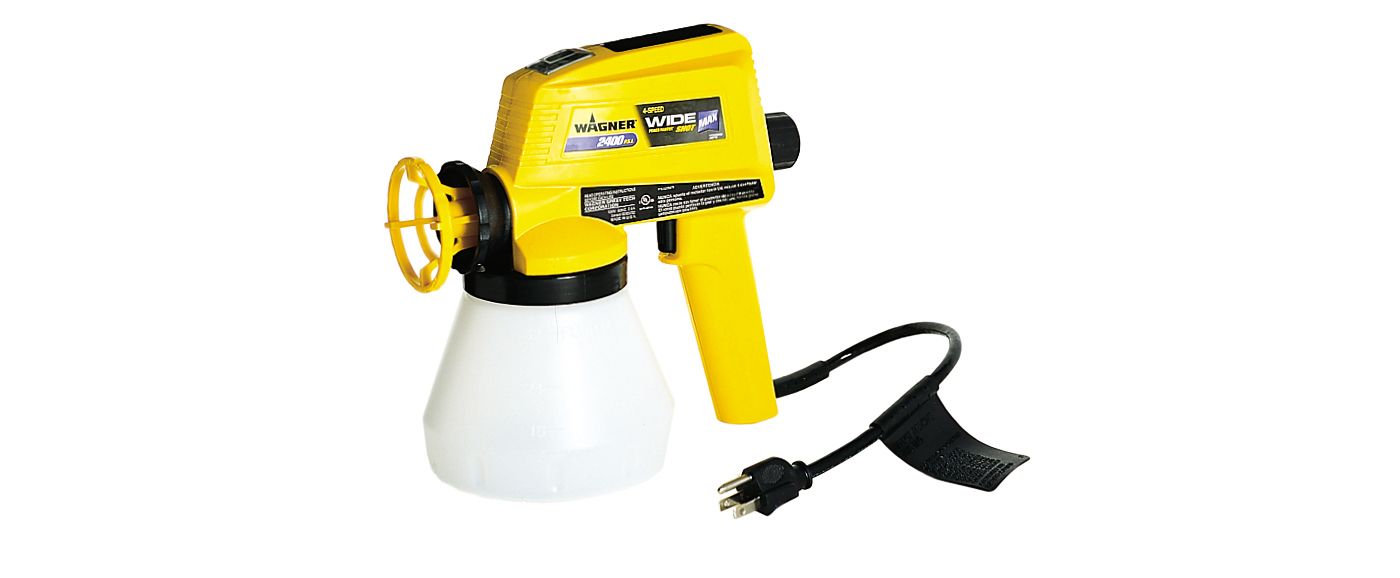
Pros: Inexpensive; better ones have enough pressure (1,800 to 2,400 psi) to handle thick latex paints as well as stains.
Cons: Don’t have power or capacity for big jobs; least expensive models (1,400 to 1,600 psi) sputter and can’t handle thick paint.
Best for: Craft projects and small painting jobs.
Diaphragm-Pump

Pros: Will handle most paints without thinning and spray large areas efficiently; easier to maintain and less expensive than piston-pump sprayers.
Cons: Overspray (known as low “transfer efficiency”)—sometimes less than half the paint ends up on the work; not good for interiors.
Best for: Decks, siding, or house painting.
Piston-Pump
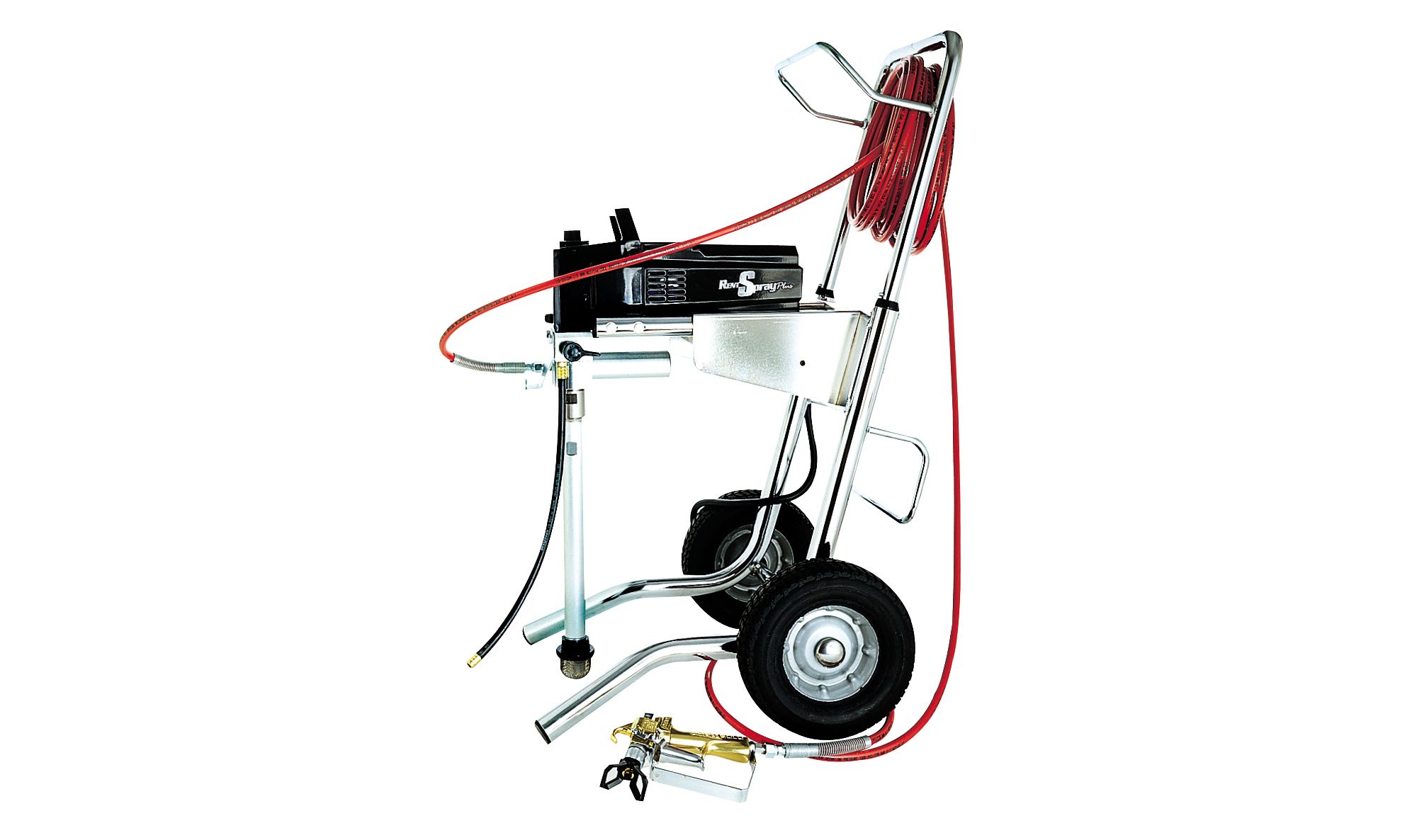
Pros: Most powerful sprayer type; can spray high volumes of any coating quickly.
Cons: Overspray; more complicated maintenance; most expensive.
Best for: House painting
Air-Compressor Gun

Pros: If you already own an air compressor, all you need is a gun and a hose; produces very smooth finish.
Cons: Has the greatest overspray of any rig; can’t spray thick paint.
Best for: Finishing furniture and cabinets—anything you can isolate in a closed spray booth.
High Volume/Low Pressure (HVLP)
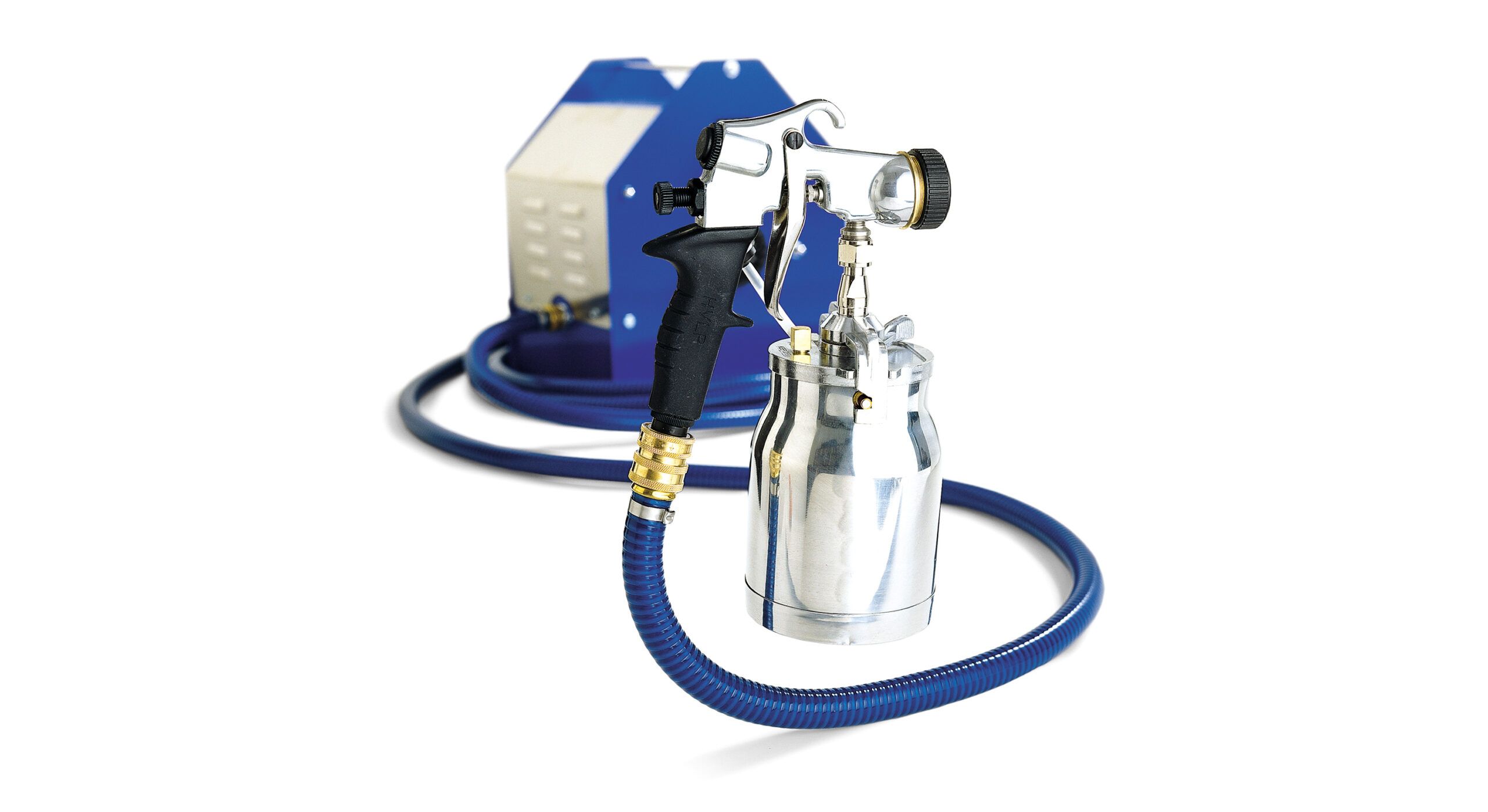
Pros: Good for interior use since low pressure (3 to 10 psi) creates little overspray and a very smooth finish; mid-range cost.
Cons: Can’t spray thick paint.
Best for: Finishing inside trim, cabinets, moldings, and doors.
Picking the Right Gun Tip
Many spray guns have interchangeable tips. Which one you choose depends on the coating you’re applying and the size of your workpiece. Manufacturers use a numbering system that’s easy to decipher: The first digit refers to half the width of the spray, or fan, from 12 inches away, and the rest of the number denotes the size of the opening in thousandths of an inch. For example, a “517” has a 10-inch-wide fan and a .017-inch orifice.

Below are general guidelines for orifice sizes matched to coatings, but consult the manufacturer’s literature.
- Enamels: .013 to .015
- Exterior latex paints: .015 to .019
- Lacquers, shellacs, stains, and water sealer: .009 to .013
- Oil-based coatings and interior latex paints: .013 to .017
Paint Sprayer Uses
Paint sprayers are excellent options for large projects in or around your home. They not only save time, but also can produce a smoother, more consistent finish. Here are some ways we best recommend using a paint sprayer at home.
- Painting ceilings or large walls
- Covering decks or patios
- Refinishing furniture
- Painting kitchen or bathroom cabinets
- Touching up doors and trim
- Adding color to wood or metal fences
- Finishing garage or basement floors
- Coloring garden furniture or decor
- Changing the color of automobiles
- Painting shutters
How To Use a Paint Sprayer
Once you know your project, have determined the best type of paint sprayer for you, and chosen a product, it’s time to get to work. Here are some tips for how to safely and effectively use a paint sprayer.
Preparation
Mask off everything (windows, shrubs, cars) with taped drop cloths or plastic to shield from overspray, and protect yourself with a respirator, goggles, and hood. For the smoothest finish, thin down the coating. Painting contractor John Dee prefers quick-evaporating naphtha for oil-based finishes, which helps the paint dry before it sags, and latex paint thinner for water-based coatings.
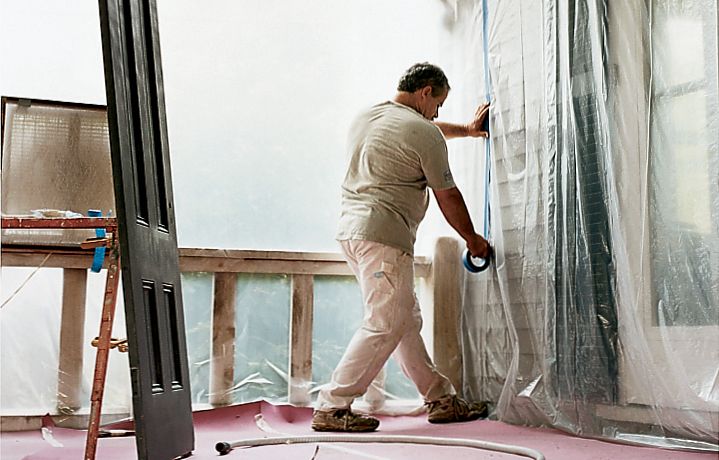
Fan Settings
Some guns have an adjustable tip, which allows you to change the size and shape of the fan of paint it puts out. Test your gun before spraying to find a shape and volume that helps you control the overspray but still gives efficient, effective coverage.
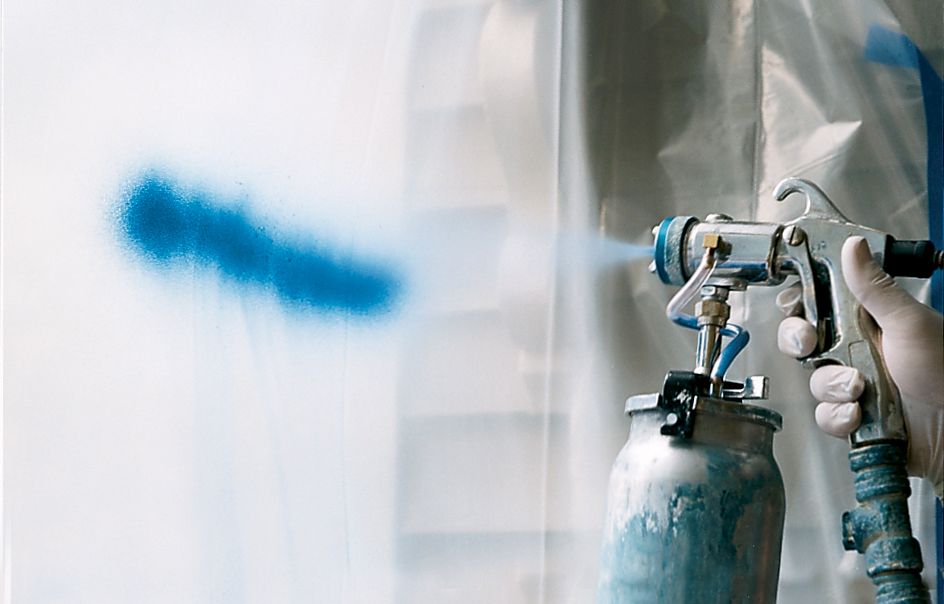
Hand Position
Point the gun straight at the surface, holding the tip about 12 inches away. If the gun is angled, the spray will be thicker on one side than the other. Move your arm, not your wrist, to keep the gun straight.
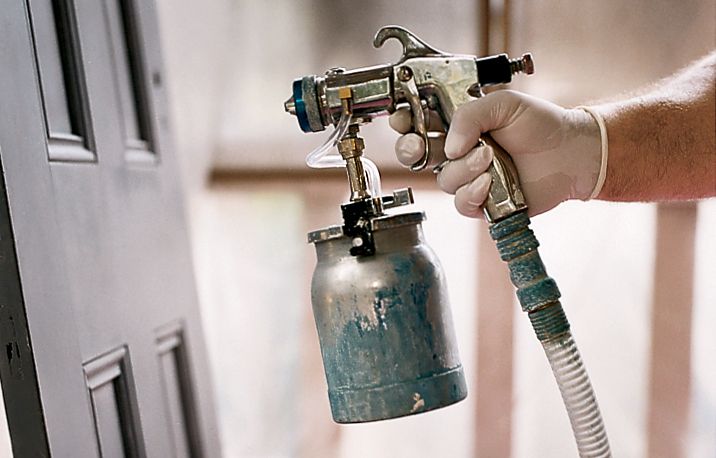
Spraying Motion
To avoid buildup, start spraying off one side of the workpiece, and don’t release the trigger until the spray has passed the other end. If you’re painting a wall or other surface with no edge, start moving your arm before pulling the trigger, and release it before you finish the motion. Overlap each pass about an inch to avoid sags or thin spots.
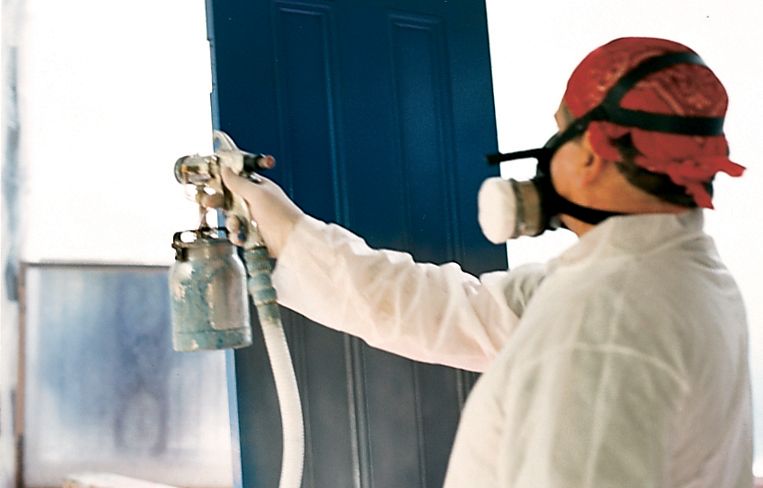
The Box-Coat Technique
John Dee builds up thin coats of finish using a spray pattern he calls the “box-coat technique,” in which he lays down the paint first horizontally, then vertically. This method works especially well on paneled doors and cabinets. Orient the tip so the fan sprays in a vertical line for the horizontal pass, then turn it 90 degrees for the vertical pass.
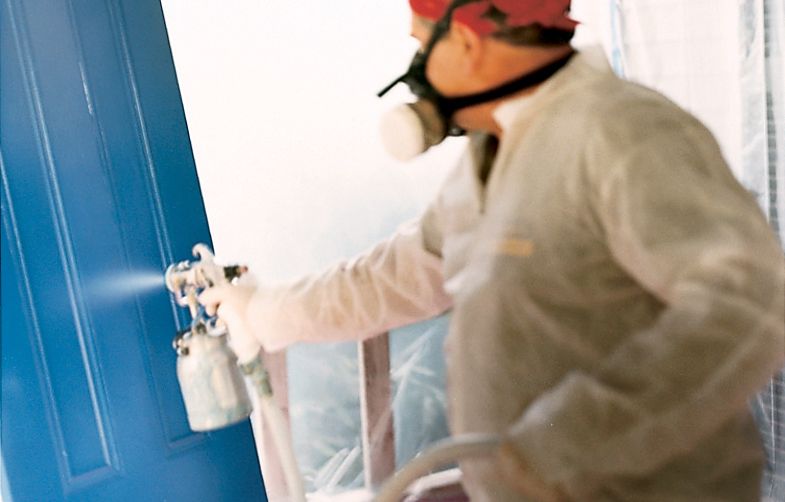
Cleanup
Paint that has dried in a sprayer’s hose or gun can cause paint clogs that make the sprayer sputter and spatter. Immediately after use, remove the tip and soak it in the appropriate solvent (water for water-based coatings, thinner for oil-based), rinse out the cup with the same solvent, then run more solvent through the lines and cups until all the paint is flushed out and the solvent runs clean.
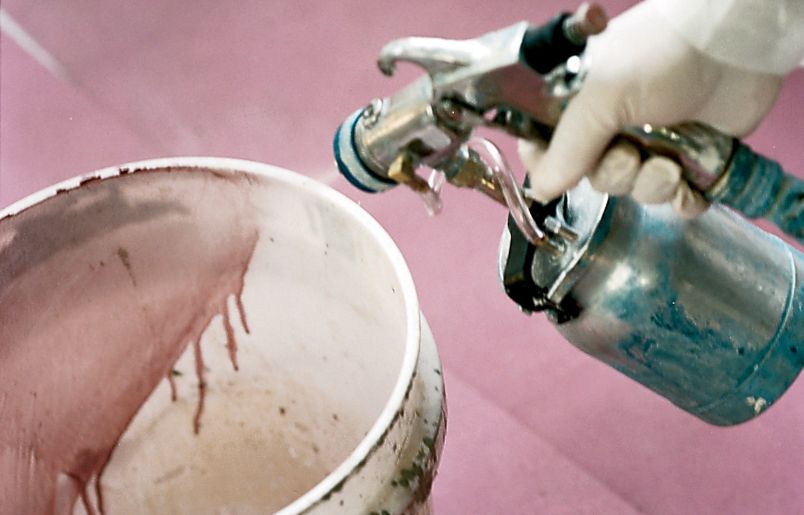
Paint Sprayer FAQs
How do I stay safe while I’m using a paint sprayer?
We recommend using eye and ear protection while painting with a sprayer. This protects your eyes from paint and your ears from hearing loss.
What type of paint sprayer should I use inside?
Gas-powered airless sprayers and compressed sprayers are loud, so we recommend avoiding these when you’re spraying indoors. If you’re doing detailed work, consider using an HVLP sprayer. However, if you’re painting a large area indoors, an electric airless sprayer will work better.
How do I unclog a paint sprayer?
If the tip gets clogged, remove it and soak it in a bowl of water for a few minutes. While it’s still wet, blow out any remaining residue or clean it with a cotton swab. You’ll then want to dry it with a cloth and reattach it to the sprayer. Before continuing to paint with it, make sure it’s spraying correctly by testing it on a piece of paper.
Our Methodology
This Old House has empowered homeowners and DIYers for more than four decades with top-notch home improvement advice in the form of television programs, print media, and digital content. Our team focuses on creating in-depth product and service review content. To date, we’ve published over 1,600 reviews on products in the home space, including power tools, outdoor equipment, major appliances, kitchen gadgets, electronics, and more that focus on product quality and helpfulness to our readers.
To provide our readers with the best recommendations possible, we rely on several key sources of information to help guide our selection process.
Initial Research: Our research process began by generating a list of products with a significant number of verified buyer reviews and an average customer review rating of 4–5 stars. We looked at positive and negative reviews alike, focusing on information from both satisfied and critical buyers.
Expert Insights: To complement our in-house expertise, our team looked at reviews and videos from trusted publications and independent testers, spoke with subject matter experts, and drew insights from reader contributions.
Final Product Selection: We then began fine-tuning our list by replacing older models with the latest versions and eliminating any discontinued models. From there, we compared each model’s feature set to create a final shortlist, selecting the best-in-class options for various buyers, budgets, and scenarios.
Once we conclude our research, we craft a comprehensive, user-friendly article of recommended products and additional information to help our readers make the right purchase.
Questions or Comments?
To share feedback or ask a question about this article, send a note to our Reviews Team at reviews@thisoldhousereviews.com.
